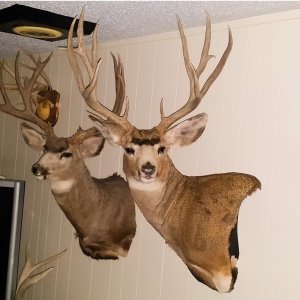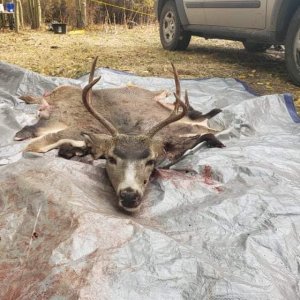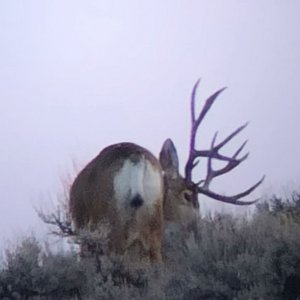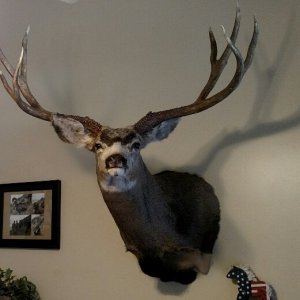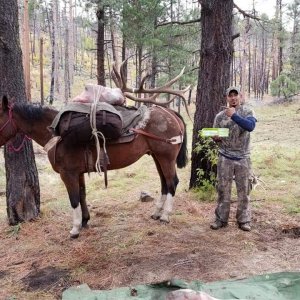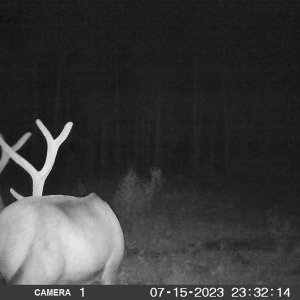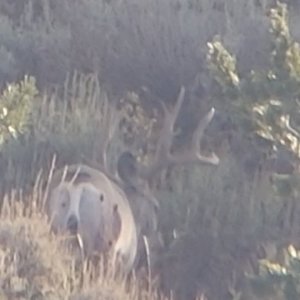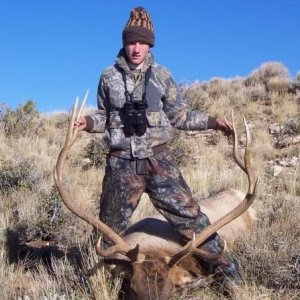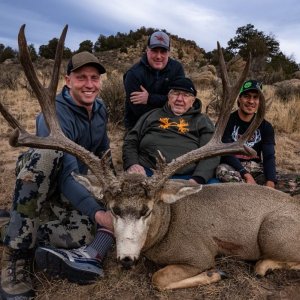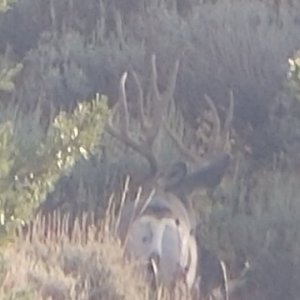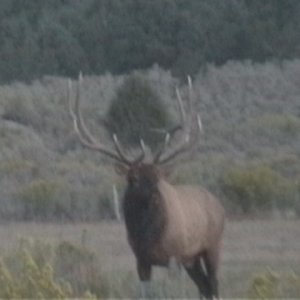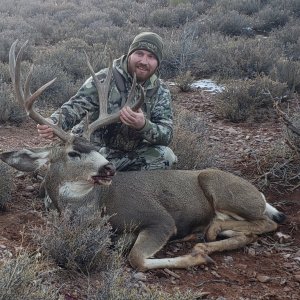Horniac
Very Active Member
- Messages
- 1,328
The view of the two mountain goats bedded below us. In the first picture you can just make them out right in the center in the sun just below the shadow line at the edge of the ravine...

A couple of pictures through the spotting scope...


Out of range of my open sighted muzzleloader and a long shot with my rifle. We are not sure about the cliffs beyond the goats and possible issues with recovery so we decide to wait them out. It is still early, we have the thermals rising up the mountain, the weather is good, and they are not aware of our presence. We keep hearing rocks rolling to the north and also just below us and every once in a while we can smell goats but we see no others despite our constant glassing of these areas.
After a few hours our two goats get up and feed closer. They are now within 325 yards and then bed again. I ask Jon if this billy is as good as he thought he was when he was looking at him yesterday and he confirms that he is an exceptional billy. He is a definite shooter in Jon's professional opinion. The nanny is no slouch either. Her horns have to be over 10" but of course her horn mass is nowhere close to that of the billy and he dwarfs her in body size. I want to shoot a billy even though I possess an either sex tag. This picture shows the timbered peak in the background that we located the goats from the afternoon before...

We discuss trying to get down through the cliffs to make a stalk to get within muzzleloader range but the basin is dead quiet and I am worried about them hearing us plowing through the drifts of snow. Jon agrees with my assessment. We also don't have a good route down to them as the basin is very open. We decide to wait them out. The goats afternoon beds from the day before are 242 yards below and to the left of us. When they left them last night they fed across the slope directly below us and ended up approximately 150 yards to the right of our current location at roughly the same elevation as us. They were still feeding when we hit the trail back towards camp. More time passes and they get up and start feeding laterally on the slope away from us. They are going to pass below a fold in the terrain and a timbered bench where we will lose sight of them. We are hoping they will reappear up the basin and closer to us. We don't see them and wait them out for a couple of more hours but they don't reappear. We hate to lose our vantage point above them in the cliffs but it is now around noon and we are getting antsy. We decide to load up our packs and try to find a route down through the cliffs to get to their afternoon beds and hopefully relocate them from there. No sooner than we get things loaded up than Jon spots them again working their way towards us. They must have went around the little timbered knob in the lower left hand corner of the photo and up the ravine. They reappeared walking right to left just below the little sliver of jack pines right above the branches in the foreground of the picture...

The nanny beds down and ten minutes later the billy is bedded 212 yards below us. Still too far to risk a shot from my open sighted muzzleloader - I have heard way too many stories of their amazing ability to soak up lead and don't want to be trailing a wounded goat through this rough country. However, even with the steep downhill angle, this is a very doable shot for my rifle. I ask Jon if he thinks we should wait or if I should go ahead and try and take him with my rifle. Jon said they might get closer but again they might not so it is up to me. He repeats he is an exceptional goat, and adds if it was his tag, he would have shot him three hours ago. I told him I would rather wait for him to stand but Jon thinks he is in a good spot for recovery if I can anchor him in his bed. I ask Jon to hand me my rifle. I want to see what type of rest I can get and want to at least check the sight picture. I work laterally across the cliff to find an open lane to shoot through to cut down on the steep downward angle I will have to hold my rifle. I finally find a spot and get somewhat of a comfortable rest on a big rock. Jon asks if I am going to take the shot. The billy is laying right to left slightly quartering to us with his vitals exposed. I turn the Leupold scope up to 14x and tell Jon I am going to dryfire my rifle a few times to see if I am able to adequately control the sight picture and cross-hairs. After three or so dryfires, I tell Jon I feel good about the shot and I will take it. Jon tells me to just keep firing and he will keep track of the billy. I put a live round in the chamber of my 300WSM Kimber Montana. I am shooting Federal Premiums with a 165 grain Barnes Triple Shock. My rifle is sighted in just under 2" high at 100 yards and is dead-on at 200. I hold low on the hair of the bedded billy to compensate for the the steep downhill angle and slowly squeeze the trigger. At the shot, I lose sight of the billy as the rifle recoils but I am already in the process of jacking in another round as Jon says he is up and to shoot again. I find the billy standing broadside facing towards the right. I hold on his shoulder and fire another round. This time I see him shudder under the impact of the shot and the big billy takes a few steps uphill. Jon says he is hit hard as the the billy slowly starts to lose his forward momentum and footing. As the billy tumbles backwards, snow flies as he cartwheels backwards into a snow filled wash but we only see bits and pieces come into view as he tumbles downhill as he is now almost entirely below our line of sight. We are not sure about the 1st shot but Jon said he heard a big whaap. Again, mountain goats can absorb a lot of lead. Although we can't see him, Jon says he is done as the nanny watches over the snow filled wash where we think he has come to rest. She stands there for about five minutes before she finally starts to move slowly off. We celebrate briefly but know the work has just begun. It is now 1:30 in the afternoon. We work our way back to the top of the mountain, and Jon leaves a cell phone message for Neil. Jon unloads his pack and I remove the pack bag from my new Outdoorsmans Pack. We leave the rifle and muzzleloader and other gear. Neil will hopefully get the phone message and grab our gear and bring it back to camp for us. He should have no problem following our tracks in the snow. I strap on the meat hauling frame and Jon shoulders his pack. We start back down the mountain about 2:30 PM and after several attempts, find a way through the cliffs. The snow is starting to melt where the eastern facing slope has seen sun and it is slippery in these spots. We reach the billy about 4:00 PM and I am amazed at his body size. His horns are buried in the snow and when I pick him up we notice his left horn tip is broke off, apparently from the fall. Unfortunate but no worries, nothing my taxidermist can't fix.

a close-up of his horns...

We labor to drag the heavy billy out of the wash and up on the slope where we can get some better pictures and work on him for the pack out.
Jon with the hard earned billy goat...

Horniac with his once-in-a-lifetime Utah billy...



Jon starts the dorsal cut on the cape for a life size mount. We bone out the meat for the pack out to try and minimize the weight. Jon loads all the boned out meat into his pack and I load the full wet cape and head onto my meat hauling frame. Jon's pack must weight at least 80# and mine 60#. It is now approximately 5:45 and sunset is around 7:00 PM so we discuss our options for the hike out. We can go back over the top of the peak and back down to camp (shortest but steepest), sidehill across the basin and hit the trail in the saddle (rough and not sure of terrain, cliffs, etc), or drop down to the trail we can see below and make the long uphill climb back to the saddle (safest but the longest and we lose all elevation). We decide that going back over the top is not a good option as it is too steep with these heavy packs and we don't have a a good route through the cliffs. Going side-hill this late in the day would be too risky if we got hung up in some unseen cliffs at dark so we rule out this option as well. Although we hate to lose the elevation and don't look forward to the long uphill hike back up the trail to the saddle, we decide that this would be the safest route to take.
In the picture below you can see the trail to the left of the big brown rock formation in the ravine. We are aiming to intercept the trail in the big snow filled clearing to the right of the ravine by traveling down the snow filled chute and crossing into the clearing where the strip of dirt is in the bottom of the photo...

This photo is taken looking further south and the saddle we need to hit is just below the saddle to the right of the timbered peak. The side-hill route would have been across this basin as viewed in this photo albeit a few hundred yards lower in elevation...

After making our way slowly down the chute we make it safely to the big clearing and intercept the trail right at sunset. We stop in the timber for a much needed and deserved break and take off our packs. After some water, candy bars, and some jerky Jon had stashed in his pack, we are feeling a little better. As we rest, we discuss dropping our packs and coming back for them in the morning. Jon was also worried about Niel as we did not have cell service here and he was out of radio range. He was having problems with this knee and Jon hoped he was safely back in camp. We didn't rest long as we didn't want to stiffen up and it is getting dark. Luckily, Jon was very familiar with this trail but he knew what lied ahead and he wasn't sure how much longer he could go on. The trail was now all uphill to the saddle and Jon had to break trail through the snow. We continued on, resting every 25 yards or so. It was now dark so we put the headlamps on. Suddenly we heard Neil's voice on the radio. He was on the trail in the saddle above us. He asked us how we were doing and Jon said he wasn't doing so good and was dying under the heavy load in his pack. Neil said he would come down the hill and take some of his load, and Jon didn't want him to do it because of his bad knee. Niel would have none of it, and said something to the effect, "that if you guys are dying, he might as well come down and die with us". We then saw his headlight bobbing down the trail. When he reached us, Jon gave him some of the bagged meat and we all labored up the steep trail. After gaining several hundred feet more, Jon told us he was hitting the wall and asked Neil if he could take another quarter. Neil added another bag of meat to his pack and we again plodded up the trail retracing Neil's steps. We finally hit the saddle and Neil asks me how I am doing. I am very fatigued as well even with my lighter pack but tell him I think I can make it back to camp OK. We all decide we should just press on and get it over with. Neil also told us he had got Jon's phone message and he had found our stashed gear on the mountain and got it all back to camp for us! All we had was about 3/4 of a mile to go back to camp. The trail was still slightly uphill but just a gradual incline except in a couple of spots so it wasn't too bad. We finally got back to camp about 9:30 PM cold, wet with perspiration, and tired, but very happy. We wolfed down Neil's awesome dutch oven cooked chicken breasts and vegetables before taking "wipe" baths, changing into some fresh clothes, and all drifting off to sleep. We slept in the next morning and had a big breakfast of pancakes and bacon before breaking camp...

We got the camp loaded onto the horses and hit the trail about 11:00 AM. Because the melting snow on the west facing slope had made the trail very slippery, we walked the horses the first 1/2 mile or so. Unfortunately, Jon had to walk his horse all the way down because we used his horse to carry the cape down. We hit the trailhead about 2:30 PM, loaded the horses and gear, and arrived back in Tooele about 5:00 PM. I brought about 3 pounds of salt with me in my truck so we spread out the cape and salted it down for the 10 hour ride home to Northern CA. I loaded my gear and we said our good-byes and I headed out of town. After stopping for some block ice for the meat in the ice-chest and the cape in the other ice-chest, I got on I-80 and stared the long drive home arriving at my house around 2:30 AM the next morning. After a few hours sleep, I was up and took my cape to the taxidermist and the meat to the butcher shop right after that. I needed to pick-up the horns after he was done with the cape because I needed the measurements for my harvest survey. My taxidermist boiled the skull for me and it looks pretty cool in my game room!

A big thanks to Jon and Neil Crump for a great, once-in-a-lifetime hunt. They did a great job outfitting my hunt and I really enjoyed the whole experience. I hope to hunt with them again someday. Also, thanks to MountainTime and KTC and others from this site for all their help and advice!
I hope you guys enjoyed the story and photos...
Horniac
PS - some info because some of you have asked for it and for those future goat hunters who want to get some reference on horn measurements and such from a harvested Utah goat:
* I drew the non-resident random tag with 9 points.
* The photos with the dates were taken with a Nikon Coolpix 7900.
* The photos without dates were taken with a Canon SD950 IS.
* The billy had 4 growth rings so I am guessing he is 5.
* Tip to tip spread = 6 0/8"
* Greatest spread = 6 3/8"
* The longest horn was 9 4/8"
* The broken horn was 8 2/8"
* Both basal circumferences were 5 1/2"
* Both 1st quarter measurements were 4 3/8"
* Both 2nd quarter measurements were 3 0/8"
* Both 3rd quarter measurements were 1 5/8"
* Gross green score if the other horn wasn't broken = 48
* Net green score if the other horn wasn't broken = 48
* Gross green score as-is (broken) = 46 6/8
* Net green score as-is (broken) = 45 4/8

A couple of pictures through the spotting scope...


Out of range of my open sighted muzzleloader and a long shot with my rifle. We are not sure about the cliffs beyond the goats and possible issues with recovery so we decide to wait them out. It is still early, we have the thermals rising up the mountain, the weather is good, and they are not aware of our presence. We keep hearing rocks rolling to the north and also just below us and every once in a while we can smell goats but we see no others despite our constant glassing of these areas.
After a few hours our two goats get up and feed closer. They are now within 325 yards and then bed again. I ask Jon if this billy is as good as he thought he was when he was looking at him yesterday and he confirms that he is an exceptional billy. He is a definite shooter in Jon's professional opinion. The nanny is no slouch either. Her horns have to be over 10" but of course her horn mass is nowhere close to that of the billy and he dwarfs her in body size. I want to shoot a billy even though I possess an either sex tag. This picture shows the timbered peak in the background that we located the goats from the afternoon before...

We discuss trying to get down through the cliffs to make a stalk to get within muzzleloader range but the basin is dead quiet and I am worried about them hearing us plowing through the drifts of snow. Jon agrees with my assessment. We also don't have a good route down to them as the basin is very open. We decide to wait them out. The goats afternoon beds from the day before are 242 yards below and to the left of us. When they left them last night they fed across the slope directly below us and ended up approximately 150 yards to the right of our current location at roughly the same elevation as us. They were still feeding when we hit the trail back towards camp. More time passes and they get up and start feeding laterally on the slope away from us. They are going to pass below a fold in the terrain and a timbered bench where we will lose sight of them. We are hoping they will reappear up the basin and closer to us. We don't see them and wait them out for a couple of more hours but they don't reappear. We hate to lose our vantage point above them in the cliffs but it is now around noon and we are getting antsy. We decide to load up our packs and try to find a route down through the cliffs to get to their afternoon beds and hopefully relocate them from there. No sooner than we get things loaded up than Jon spots them again working their way towards us. They must have went around the little timbered knob in the lower left hand corner of the photo and up the ravine. They reappeared walking right to left just below the little sliver of jack pines right above the branches in the foreground of the picture...

The nanny beds down and ten minutes later the billy is bedded 212 yards below us. Still too far to risk a shot from my open sighted muzzleloader - I have heard way too many stories of their amazing ability to soak up lead and don't want to be trailing a wounded goat through this rough country. However, even with the steep downhill angle, this is a very doable shot for my rifle. I ask Jon if he thinks we should wait or if I should go ahead and try and take him with my rifle. Jon said they might get closer but again they might not so it is up to me. He repeats he is an exceptional goat, and adds if it was his tag, he would have shot him three hours ago. I told him I would rather wait for him to stand but Jon thinks he is in a good spot for recovery if I can anchor him in his bed. I ask Jon to hand me my rifle. I want to see what type of rest I can get and want to at least check the sight picture. I work laterally across the cliff to find an open lane to shoot through to cut down on the steep downward angle I will have to hold my rifle. I finally find a spot and get somewhat of a comfortable rest on a big rock. Jon asks if I am going to take the shot. The billy is laying right to left slightly quartering to us with his vitals exposed. I turn the Leupold scope up to 14x and tell Jon I am going to dryfire my rifle a few times to see if I am able to adequately control the sight picture and cross-hairs. After three or so dryfires, I tell Jon I feel good about the shot and I will take it. Jon tells me to just keep firing and he will keep track of the billy. I put a live round in the chamber of my 300WSM Kimber Montana. I am shooting Federal Premiums with a 165 grain Barnes Triple Shock. My rifle is sighted in just under 2" high at 100 yards and is dead-on at 200. I hold low on the hair of the bedded billy to compensate for the the steep downhill angle and slowly squeeze the trigger. At the shot, I lose sight of the billy as the rifle recoils but I am already in the process of jacking in another round as Jon says he is up and to shoot again. I find the billy standing broadside facing towards the right. I hold on his shoulder and fire another round. This time I see him shudder under the impact of the shot and the big billy takes a few steps uphill. Jon says he is hit hard as the the billy slowly starts to lose his forward momentum and footing. As the billy tumbles backwards, snow flies as he cartwheels backwards into a snow filled wash but we only see bits and pieces come into view as he tumbles downhill as he is now almost entirely below our line of sight. We are not sure about the 1st shot but Jon said he heard a big whaap. Again, mountain goats can absorb a lot of lead. Although we can't see him, Jon says he is done as the nanny watches over the snow filled wash where we think he has come to rest. She stands there for about five minutes before she finally starts to move slowly off. We celebrate briefly but know the work has just begun. It is now 1:30 in the afternoon. We work our way back to the top of the mountain, and Jon leaves a cell phone message for Neil. Jon unloads his pack and I remove the pack bag from my new Outdoorsmans Pack. We leave the rifle and muzzleloader and other gear. Neil will hopefully get the phone message and grab our gear and bring it back to camp for us. He should have no problem following our tracks in the snow. I strap on the meat hauling frame and Jon shoulders his pack. We start back down the mountain about 2:30 PM and after several attempts, find a way through the cliffs. The snow is starting to melt where the eastern facing slope has seen sun and it is slippery in these spots. We reach the billy about 4:00 PM and I am amazed at his body size. His horns are buried in the snow and when I pick him up we notice his left horn tip is broke off, apparently from the fall. Unfortunate but no worries, nothing my taxidermist can't fix.

a close-up of his horns...

We labor to drag the heavy billy out of the wash and up on the slope where we can get some better pictures and work on him for the pack out.
Jon with the hard earned billy goat...

Horniac with his once-in-a-lifetime Utah billy...



Jon starts the dorsal cut on the cape for a life size mount. We bone out the meat for the pack out to try and minimize the weight. Jon loads all the boned out meat into his pack and I load the full wet cape and head onto my meat hauling frame. Jon's pack must weight at least 80# and mine 60#. It is now approximately 5:45 and sunset is around 7:00 PM so we discuss our options for the hike out. We can go back over the top of the peak and back down to camp (shortest but steepest), sidehill across the basin and hit the trail in the saddle (rough and not sure of terrain, cliffs, etc), or drop down to the trail we can see below and make the long uphill climb back to the saddle (safest but the longest and we lose all elevation). We decide that going back over the top is not a good option as it is too steep with these heavy packs and we don't have a a good route through the cliffs. Going side-hill this late in the day would be too risky if we got hung up in some unseen cliffs at dark so we rule out this option as well. Although we hate to lose the elevation and don't look forward to the long uphill hike back up the trail to the saddle, we decide that this would be the safest route to take.
In the picture below you can see the trail to the left of the big brown rock formation in the ravine. We are aiming to intercept the trail in the big snow filled clearing to the right of the ravine by traveling down the snow filled chute and crossing into the clearing where the strip of dirt is in the bottom of the photo...

This photo is taken looking further south and the saddle we need to hit is just below the saddle to the right of the timbered peak. The side-hill route would have been across this basin as viewed in this photo albeit a few hundred yards lower in elevation...

After making our way slowly down the chute we make it safely to the big clearing and intercept the trail right at sunset. We stop in the timber for a much needed and deserved break and take off our packs. After some water, candy bars, and some jerky Jon had stashed in his pack, we are feeling a little better. As we rest, we discuss dropping our packs and coming back for them in the morning. Jon was also worried about Niel as we did not have cell service here and he was out of radio range. He was having problems with this knee and Jon hoped he was safely back in camp. We didn't rest long as we didn't want to stiffen up and it is getting dark. Luckily, Jon was very familiar with this trail but he knew what lied ahead and he wasn't sure how much longer he could go on. The trail was now all uphill to the saddle and Jon had to break trail through the snow. We continued on, resting every 25 yards or so. It was now dark so we put the headlamps on. Suddenly we heard Neil's voice on the radio. He was on the trail in the saddle above us. He asked us how we were doing and Jon said he wasn't doing so good and was dying under the heavy load in his pack. Neil said he would come down the hill and take some of his load, and Jon didn't want him to do it because of his bad knee. Niel would have none of it, and said something to the effect, "that if you guys are dying, he might as well come down and die with us". We then saw his headlight bobbing down the trail. When he reached us, Jon gave him some of the bagged meat and we all labored up the steep trail. After gaining several hundred feet more, Jon told us he was hitting the wall and asked Neil if he could take another quarter. Neil added another bag of meat to his pack and we again plodded up the trail retracing Neil's steps. We finally hit the saddle and Neil asks me how I am doing. I am very fatigued as well even with my lighter pack but tell him I think I can make it back to camp OK. We all decide we should just press on and get it over with. Neil also told us he had got Jon's phone message and he had found our stashed gear on the mountain and got it all back to camp for us! All we had was about 3/4 of a mile to go back to camp. The trail was still slightly uphill but just a gradual incline except in a couple of spots so it wasn't too bad. We finally got back to camp about 9:30 PM cold, wet with perspiration, and tired, but very happy. We wolfed down Neil's awesome dutch oven cooked chicken breasts and vegetables before taking "wipe" baths, changing into some fresh clothes, and all drifting off to sleep. We slept in the next morning and had a big breakfast of pancakes and bacon before breaking camp...

We got the camp loaded onto the horses and hit the trail about 11:00 AM. Because the melting snow on the west facing slope had made the trail very slippery, we walked the horses the first 1/2 mile or so. Unfortunately, Jon had to walk his horse all the way down because we used his horse to carry the cape down. We hit the trailhead about 2:30 PM, loaded the horses and gear, and arrived back in Tooele about 5:00 PM. I brought about 3 pounds of salt with me in my truck so we spread out the cape and salted it down for the 10 hour ride home to Northern CA. I loaded my gear and we said our good-byes and I headed out of town. After stopping for some block ice for the meat in the ice-chest and the cape in the other ice-chest, I got on I-80 and stared the long drive home arriving at my house around 2:30 AM the next morning. After a few hours sleep, I was up and took my cape to the taxidermist and the meat to the butcher shop right after that. I needed to pick-up the horns after he was done with the cape because I needed the measurements for my harvest survey. My taxidermist boiled the skull for me and it looks pretty cool in my game room!

A big thanks to Jon and Neil Crump for a great, once-in-a-lifetime hunt. They did a great job outfitting my hunt and I really enjoyed the whole experience. I hope to hunt with them again someday. Also, thanks to MountainTime and KTC and others from this site for all their help and advice!
I hope you guys enjoyed the story and photos...
Horniac
PS - some info because some of you have asked for it and for those future goat hunters who want to get some reference on horn measurements and such from a harvested Utah goat:
* I drew the non-resident random tag with 9 points.
* The photos with the dates were taken with a Nikon Coolpix 7900.
* The photos without dates were taken with a Canon SD950 IS.
* The billy had 4 growth rings so I am guessing he is 5.
* Tip to tip spread = 6 0/8"
* Greatest spread = 6 3/8"
* The longest horn was 9 4/8"
* The broken horn was 8 2/8"
* Both basal circumferences were 5 1/2"
* Both 1st quarter measurements were 4 3/8"
* Both 2nd quarter measurements were 3 0/8"
* Both 3rd quarter measurements were 1 5/8"
* Gross green score if the other horn wasn't broken = 48
* Net green score if the other horn wasn't broken = 48
* Gross green score as-is (broken) = 46 6/8
* Net green score as-is (broken) = 45 4/8

